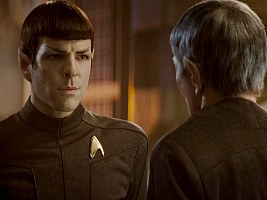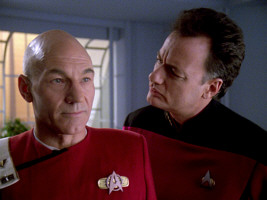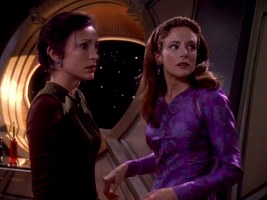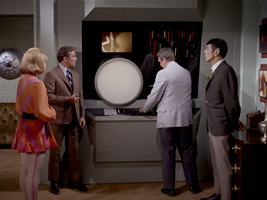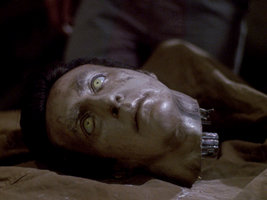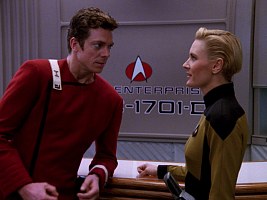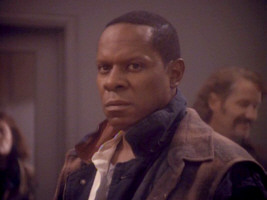Time Travel - General Considerations
"Ever since my first day as a Starfleet captain, I swore I'd never let myself get caught in one of these Godforsaken paradoxes. The past is the future, the future is the past, it all gives me a headache."(Capt. Janeway, VOY: "Future's End")
Time travel is one of the most popular and most interesting topics in science fiction. The motivation for a character to travel in time, provided that it is intentional, is either to rectify events in the past or to explore the past or future. However, there seems to be a danger of causing a paradox in the timeline, especially when going to the past. The best-known dilemma occurs if the time traveler goes back something like 70 years to the past and inadvertently kills his grandfather before grandpa has met grandma. He is extinguishing his own existence in the very same moment. If he will never exist in the future, there is no one to go back to the past to cause the change in the timeline in the first place. As a result, the timeline is ambiguous since that time in the past, and the person exists and does not exist at the same time from a logical viewpoint, at least in one possible interpretation.
To deal with this so-called grandfather paradox has been a challenge for many science fiction authors, and almost all of them failed to provide a logically flawless description of the phenomenon. What happens if a paradox occurs? Since a paradox by its very nature is unsolvable, is it actually allowed to happen? Is there a theory of time travel without paradox? The following considerations focus on the logical feasibility of time travel and do not involve a physical or eventually a technical solution of the problem.
Definition of Time Travel
A movement in the three dimensions of space is defined as the change of a position with respect to time. If a distance s is traversed in a time t, the motion is described by the speed with an absolute value v=s/t. In a broad sense, using an analogous definition, movement through time, or time travel, is a change of time with regard to time. It is obvious that one "time" cannot be equal to the other "time" in this statement that would otherwise be irrelevant. In a useful definition for time travel the first "time" represents the elapsed time in the rest of the world (external time, te) and the second "time" the time experienced by the time traveler (internal time, ti). So it is possible to define a parameter similar to speed also for time travel. Time speed vt, as we could denote it, is dimensionless and is given as the ratio of external time to internal time vt=te/ti. The time traveler sitting in his time machine can measure time speed by comparing his own clock to a clock (or calendar) in the outer world.
An easy way to illustrate the feasible values for vt is to relate them to video cassette recorder operations, which also reflect the impression the time traveler gets from the world outside while traveling. This point-of-view is described e.g. in H. G. Wells's groundbreaking novel The Time Machine, where the passenger of the time machine heading for the future (vt>1) perceives the outer world in quick motion forward.
| Symbol | VCR operation mode | Time speed vt | Description |
| (Fast) reverse | <0 | Traveling back in external time | |
| Pause | 0 | External time stands still | |
| Slow motion | <1 | External time elapses slowly | |
| Play | 1 | Normal course of time | |
| Fast forward | >1 | Traveling forward in external time |
In the special case vt=0, according to the above definition, no time travel occurs and the time traveler "lives for the moment". It may surprise that, strictly speaking, the normal course of time is a time travel, since vt=1>0. In this respect the whole universe is on a continuous time travel. In fact, time is definitely not standing still in our world, since (spatial) motion of elementary particles, clocks, people, planets and galaxies exist and can be measured. A sort of time travel 50 years to the future is possible just by waiting 50 years. Yet, this definition of time travel does not correspond with common sense.
Time travel as described by science fiction authors usually takes place in the ranges of vt>1 (to the future) and vt<0 (to the past). The slow motion movement for vt<1 is not as popular as "real" time travels, however, it has been impressively described in TOS: "Wink of an Eye", TNG: "Timescape" and VOY: "Blink of an Eye", where different time zones exist simultaneously.
Time travel to the future
A movement to the future is characterized with a time speed vt>1. Since the time traveler's history is not endangered, the time travel itself is inherently not associated with paradoxes. Moreover, traveling to the future is physically and maybe technically possible in some years by means of a cryogenic chamber (like in TOS: "Space Seed" or TNG: "The Neutral Zone") or space travel at relativistic speeds. The first possibility is not really a time travel, since the cryogenic chamber remains in our space-time and only the biological functions of the passenger are slowed down. The latter method is often said to lead to the so-called twin paradox, although it is no genuine paradox and can be solved rather easily with some trigonometry. Read my introduction to FTL travel and, for more information, the Relativity FAQ if you are interested in special relativistic time dilation.
Still, with neither method it will ever be possible for the time traveler to return to the past, unless he reaches a future so advanced that a way back has been found in the meantime. Besides, a time traveler will never see his personal future for the simple reason that he spends the years in between in his cryogenic chamber, starship or time machine -- and not in a "real" life. Some authors don't take this trivial fact into account and the hero meets a future self that could not possibly exist without the time traveler's permanent presence in that timeline.
Paradoxes of Time Travel
The grandfather paradox
Time travel to the past (at a time speed vt<0) is the one that causes the commonly known problems. The nature of the paradox is that the time traveler alters the past in a way that he will not be able to go on the time travel, or worse, will even cease to exist. This is usually referred to as the grandfather paradox. Although travel to the future itself is secure as already mentioned above, it may nevertheless entail a paradox in case the time traveler, who has seen his future and does not like it, returns to the present and intentionally or subconsciously changes his future. However, in this case the paradox does not occur in the future, but in the present. It corresponds with the grandfather paradox if we simply replace "future" with "present" and "present" with "past" in the preceding sentence.
The classic grandfather paradox is best illustrated with an example. We assume that an ingenious inventor travels back 70 years to the past where he meets his grandfather as a child. There is no need to have our hero kill his poor grandpa, his mere presence in the past may be the reason why grandpa dies in an accident. Grandpa's death initiates the paradox: If grandpa dies as a child, our inventor will never exist. However, if he will never exist, he will never build a time machine and go back in time. However, if he does not go back in time, his grandpa does not die before his time. However, ... The dilemma is obvious. In more general terms, by doing something during his journey, the time traveler has made the time travel impossible in the first place.
It appears to be self-evident that a paradox is not allowed to occur. Nevertheless, if we hypothetically assume that a time travel actually leads to the grandfather paradox, how will it manifest itself? The most popular example of a paradox in progress is probably "Back to the Future I". Here the paradox does not seem to occur to its full extent, but time traveler Marty McFly is somehow dissolving inversely proportional to the probability that his parents will ever fall in love with one another. This is even harder to explain than a sudden effect of the paradox and it obviously serves as a loophole to allow the restoration of the original timeline in the nick of time and therefore create alleged consistency. The movie "Frequency" shows us a variant in which everything in the future is switched immediately following a change in the past, but John, the key figure, keeps memories of both timelines. In "Terminator II" the grandfather paradox was close to occur when Arnie destroyed everything that would enable his creation - at least that is what he intended (He actually left an arm behind that had been ripped off his body).
The ontological paradox
Something like the ontological paradox never happened in Star Trek, at least not with a palpable impact. Still, let us assume that a time traveler goes to Merry Old England to visit a young playwright named William Shakespeare at a time when he has not yet written any of his famous works. The visitor from the future hands out a large collection of books to the surprised Shakespeare. Bill thinks, "Hey, that's the greatest thing that ever happened to me." Over the years Shakespeare publishes the works one by one, pretending that he wrote them. He becomes the most celebrated writer of English language ever. Many centuries in the future, a time traveler goes to the book shop, buys the complete collection of Shakespeare's works and climbs into his time machine...
Sounds plausible so far, doesn't it? But if young Shakespeare didn't write what was published under his name, who did? The answer must be: no one! At least if we assume that there was only one timeline and it always involved the time travel, thereby forming a closed causality loop from which there is no escape. In this case Shakespeare's works simply exist in our universe, without the need to ever create them.
We may take the absurdity even one step further. Let us assume our brave time traveler doesn't buy new books, but steals the original manuscripts of William Shakespeare. Now he climbs into the time machine, goes back to Old England and gives the scripts to young Bill. Shakespeare is even more surprised because he would recognize his own hand writing. And even though the paper may be a bit worn, he decides to be lazy and keeps them as they are. Long after his death these precious "original" manuscripts are stored in a museum from where the time traveler takes them...
Here not only the idea of stage plays and poems but the very manuscripts are circulating through the time loop indefinitely. It is obvious that due to tear and wear there should not be anything left of them after a certain number of loops, but claiming they are always the very same we are really talking about them being passed on infinite times! This is impossible under the second law of thermodynamics that is essentially responsible for the manuscripts to age, unless they would somehow revert to their original state in the travel back to Shakespeare's time. But shouldn't the time traveler become some 400 years younger as well in this case? Time cannot "know" what has to be reverted and what not, can it?
Another variant of the paradox is that the time traveler goes back in time to meet his younger self, and gives him the plans to construct the time machine. This has been described as the "reverse grandfather paradox", because in such a case the time travel is enabled in the first place by a time travel, instead of being disabled. If works of art don't have to be created but simply exist in a universe where the ontological paradox is allowed, the same should hold true for technology. Perhaps even for theoretically possible technology that is so far advanced that it realistically should not be discovered for thousands of years.
Finally, we may think of a scenario in which the (male) time traveler goes back, falls in love with his mother and becomes his own father (or like Fry in Futurama, his own grandfather). This is genetically impossible, but the logic seems to be flawless.
The predestination paradox
Let us assume that our time traveler goes back to late 19th century Austria to kill a little boy named Adolf Hitler. But something goes wrong, and instead of causing Hitler's death the interference saves the life of the later dictator, who would otherwise have been killed in an accident. The actions of the time traveler don't change anything about the past; on the contrary, they have always been part of the recorded history. This is described as the predestination paradox or as Pogo paradoxx (the latter more narrowly refers to actions in the past that have the opposite of the desired outcome). The course of history, once it involves a time travel, is determined by a causality loop. The cause leads to an effect that enables the cause in the first place.
The predestination paradox itself, however, isn't really a paradox once we "promote" it to a fundamental rule of how time travel works, as in my predestination theory described below (which is a sub-theory of something more generally referred to as the Novikov self-consistency principle). The assumption that the timeline, involving any time travel that would ever happen, is predetermined, eludes the grandfather paradox, while it aggravates the ontological paradox.
Time Travel Theories
This chapter will show how different theories either circumvent or permit and handle the grandfather paradox and the ontological paradox. In order to analyze the nature of the paradoxes an absolute and omniscient observer is required, one who is not affected by changes in the timeline, perhaps a supernatural being like Q. Considering the possible timeline changes from the view of this omniscient observer, there are at least six logical solutions for the paradoxes that are discussed in the following.
In addition to the time-domain diagrams of the theories (sketched up the way the omniscient observer would perceive the timelines), I have included system descriptions where the single theories are characterized with different types of control loops. Here an input, an event in the past, leads to an output (or in one particular case two or more outputs), an event in the present. Note that each of the systems is assumed to be linear and time-invariant (LTI), the latter meaning that the system's behavior will not change irrespective of the time when it is observed. It is important to note that here the time domain in which the behavior is described is the absolute time shown on the clock of the omniscient observer. The observer may see that the output (actually this may be as little as one specific moment on a timeline that is being observed) changes forth and back or not.
Control loops I will not go into all the basics of control loops. But with a few facts in mind it may be possible to understand a bit of them even without mathematics. In the trivial case there is only a forward branch (v). In other words, the past can influence the present but not the other way round. If we allow time travel and therefore the present to have influence on the past, we can express that as a feedback loop (k), and at a summation point (+) the feedback adds to the past, possibly creating a new future or helping to stabilize the existing one (which is why it is called control loop). Feedback loops can only be stable for negative feedback, in which case the feedback counteracts a tendency of the output to increase or decrease, keeping it within limits. The actual stability criterion is a bit more complicated as it must take into account delays or phase shifts of the signals. However, if the feedback is positive, we will likely get an unstable system. It will oscillate between two states, none of which may be kept for longer than the system's built-in response time allows.
1. Oscillation theory
When a grandfather paradox occurs, the timeline is basically ambiguous from the instant of the paradox to infinity. Both states may be equally valid. Perhaps they must be equally valid, insinuating that there is nothing such as a preferred or more likely state. According to the oscillation theory, the external observer will see an oscillation between timeline 1 and timeline 2. At event 1 the time traveler causes the paradox, i.e. grandpa is killed, and the timeline switches from version 1 (grandpa is alive) to 2 (grandpa is dead). At event 2 the timeline snaps back again. Event 2 is quite hard to define and even harder to determine, if at all. This must be some moment when the change in the timeline due to event 1 inevitably prevents the time travel and therefore event 1 itself. Anyway, my oscillation theory assumes that timeline 2 is transitory and cannot be maintained any longer at event 2. We could postulate that event 2 equals event 1 in the above case, since grandpa's death ultimately prevents the inventor's birth, his time travel and finally grandpa's death itself. At this very moment the probability that his grandson is born anyway and goes on his time travel immediately decreases to zero. In this case the oscillation frequency would be theoretically infinite.
A point against this postulate is that time does not "know" about grandpa's and grandson's relationship. The grandson is a person from the future, and he may not be affected by the change in the timeline until the change reaches an event 2 in "his time". The question when will be "his time" cannot be answered. It could be the first meeting of the time traveler's grandparents or parents, his begetting or birth, the instant he has the idea to build a time machine or any other moment before or during his life. The latest possible moment for event 2 seems to be his departure to the past. Under this assumption the time traveler might believe it is possible to escape from the oscillation by going to the future again and telling his future self not to go on the time travel. However, that would only cause another loop in the loop.
We might refer to the oscillation theory to explain what we can see in most Trek episodes. We could postulate that the viewer in front of the TV screen is not an omniscient observer but rather perceives everything with the eyes of the characters. Hence, we don't see the ambiguity of the timeline, much less how it switches forth and back. However, the degree of uncertainty would rise with every persistent change of history, of which quite a few have taken place by the 24th century. Does the timeline oscillate between an ever increasing number of different versions? Is time a total mess in the Star Trek Universe? This is hard to imagine.
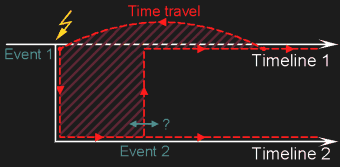
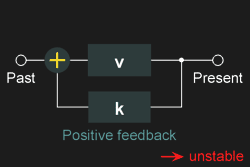
Oscillation theory: timelines and equivalent system
In a system view of the theory, we have a positive feedback that renders the system unstable. Note that the system is drawn for just two discrete times on the continuous timelines 1 and 2. These two points are the aforementioned event 1 (grandpa dies) in the past as input and an event in the present, set some time after the unknown event 2, as output. Just like shown for the continuous timelines, the equivalent system will oscillate at the output, the present. In real engineering, any system like this has a certain frequency at which it will oscillate and which is inversely proportional to the propagation time through the loop. The system model matches with the description on the timeline level. Its equations may easily include an additional term for the oscillation frequency but this naturally doesn't help to determine it. This question will be further considered for the course-of-time theory below.
Regarding the ontological paradox in the oscillation theory, there is an original timeline (or rather, one of two equally valid timelines), in which Shakespeare actually wrote his works himself. In the other timeline, Shakespeare gets the collected works from the time traveler, and it is still up to him whether he reproduces them exactly or whether he deviates from them. In any case these two versions of history are incompatible just like the two timelines in which grandpa is not killed or killed, respectively. There is no fundamental difference between the grandfather paradox and the ontological paradox in the oscillation theory. In both cases the inherent instability lets the system frequently switch between the two timelines. The wear of the manuscripts is no problem either; our omniscient observer frequently witnesses how Shakespeare writes new ones.
Side note It has to be annotated that the above oscillation is different from the one featured in TNG: "Cause and Effect". The latter is a phenomenon that leads to spatially limited reset of time, triggered by the explosion of the Enterprise-D.
2. Course-of-time theory
The problem to determine event 2 when the grandfather paradox inevitably affects the time traveler has already been discussed for the oscillation theory. Taking into account probabilities, event 2 might be extended to a period in which the probability for the time travel and also for event 1 (grandpa's death) decreases from 1 to 0. This consideration corresponds with Marty's dissolving phenomenon in "Back to the Future I", although it is naturally not possible to exist as a "semi-transparent" human being.
If it is impossible to determine an exact instant or a period for event 2, we could simply postulate that event 2 will never occur for our hero. As a consequence, if the time traveler alters anything in history, no matter whether it is related to him or not, he will not be affected as long as he stays behind in the past and does not use his time machine to travel back to the time of his departure. Moreover, he can even stay within the normal course of time until he reaches "his time". He may even stay in a timeline in which he does not exist any more. This is feasible, since the normal course of time propagates at vt=1, while "his time" also moves forward at vt=1. In this way the new timeline will never arrive in "his time" as long as the old timeline still exists. This is the course-of-time theory.
Side note The course-of-time theory should not be mistaken for an obviously artificial shielding against changes in the timeline, such as in TOS: "The City on the Edge of Forever" or DS9: "Past Tense". In the latter episode chroniton particles protect the Defiant that would otherwise not exist any more, since Sisko has unintentionally foiled the foundation of the Federation in the past. Here the mysterious particles solely serve as a plot device to allow the restoration of the original timeline, whereby the paradox is eluded, but not solved.
The problem with the course-of-time theory is that the time traveler can use his machine to get back to "his time", e.g. to the moment of his departure to the past. While in his machine, his internal time elapses very slowly compared to the external time, so from his perspective the normal course of time in the outer world is compressed. When he climbs off his machine, the paradox will immediately affect him, or this will occur to him while still in the time machine as soon as he passes an unknown event 2. To solve this problem, an absolute time speed for the propagation of time must be introduced, one which is constant with respect to any reference system, including the ones of the time traveler and of the observer. This concept sounds familiar, as it is similar with light speed in special relativity. So the new timeline set off by the time traveler will not move faster to the future than (internal) time elapses for the time traveler. In this case it does not matter whether the time traveler stays in the past or climbs into his machine to go back. In the latter case, he would simply overtake the course of time and arrive in the future he always knew. As a result, time travel in this case cannot be used to change history, and it becomes a far less interesting topic for science fiction.
No Star Trek episode or movie is based on the course-of-time theory. We can rule it out for a quite obvious reason. In Star Trek the effect of a time travel to the past always shows up immediately to someone who has remained in the present. For instance, in TOS: "The City on the Edge of Forever" Uhura loses contact with the Enterprise merely ten seconds after McCoy has traversed the Guardian of Forever. The new timeline is created in an instant and does not need 200 years of absolute time to propagate 200 years to the future from the point of divergence. As already mentioned, Star Trek would be boring if it took so long.
As a further consequence, the question might arise what future we will encounter if we travel forward in time. If we cannot shorten the course of time, we will see our actual future as late as we reach it without time machine. To allow going to the future at all under these circumstances, we must assume that there is already a timeline existing after our present, and we are able to "take possession" of it by gradually changing it within the normal course of time.
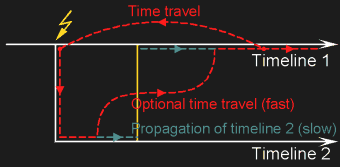
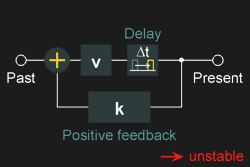
Course-of-time theory: timelines and equivalent system
The system view of the theory is explained rather fast. Essentially it is the same as of the oscillation theory, only with an additional delay in the forward path. Due to this delay any change at the summation point (the exact time when grandpa dies) will take the same time to propagate to the present for the observer and the time traveler. Remember that the observer saw the change of the timeline immediately or after a very short delay in the oscillation theory. The system of the course-of-time theory is anything but stable, only that the delay will ensure that anyone going through time himself slightly ahead of the signal will not notice the change.
If we send Shakespeare's manuscript forth and back through this system to verify the possibility of the ontological paradox, we can see that it will not occur. The explanation is the same as above for the oscillation theory.
3. Doubling theory
The third theory implies that there is no causality loop and no new timeline is displacing the old one, but the timeline is simply doubled after the paradox, allowing that two versions of history exist simultaneously without ambiguity. This is known as the many-worlds Interpretation in quantum mechanics and is also popular as the multiverse concept in science fiction. It was the central idea in the TNG episode "Parallels" where each elementary decision in the quantum level lead to the formation of a new universe. The same theory could apply to time travel paradoxes. The simple point in favor of the doubling theory is that if the paradox is not possible to be resolved within one universe, a second one is required.
The doubling theory could explain the many instances in Star Trek where a paradox should have happened, but was not visible. For example, in TNG: "Yesterday's Enterprise", Tasha Yar continues to exist on the Enterprise-C and is captured by the Romulans, although the alternative future she came from has been erased. The fact that she is there and she does remember the intermediate timeline (and tells her daughter Sela about it) may be proof that this future exists in some fashion. Still, it is not possible for Tasha to return to this timeline, at least not by another time travel, since it can be found in a different universe. Finally and most notably, quantum duplication is the official explanation of what happens in "Star Trek (2009)", according to Roberto Orci.
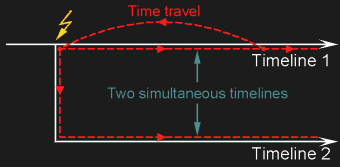
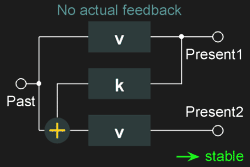
Doubling theory: timelines and equivalent system
The system describing the doubling theory is much less weird than the underlying idea of two simultaneous timelines or even two universes. Just add a second output (Present2), leave the feedback block (k) as it is but re-route the summation block to the input of the second forward path (v). The time traveler who sees grandpa die may think that there is a loop because just going from the input (Past) to the second output (Present2) the system looks the same as in the oscillation theory. But actually there is no feedback at all! Naturally this system will always be stable.
Just like the grandfather paradox, the ontological paradox is avoided in the doubling theory. It is as simply as this: The time traveler takes Shakespeare's original manuscripts to a new universe, where they are not originally written by the Shakespeare of that universe.
The three theories discussed so far deal with the paradoxes instead of just avoiding them. How this is accomplished may be beyond human imagination as it is beyond human perception. However, this is no argument against a paradox. The paradox is just not visible to (human) beings that are restricted to the "normal" space-time, although they are the ones who are concerned with it from the viewpoint of the omniscient being.
4. Prevention theory
Many people expect a "solid" time travel story to avert the grandfather paradox under all circumstances and to comply with the Novikov self-consistency principle. It has to be forbidden for the time traveler to alter his own past or any event in history that may be related to him. It must be ensured that the hero can go on his time travel again in any conceivable future.
Side note Strictly speaking, traveling to the "past" refers to the light cone, the region in space-time that constitutes a person's past, present and future. The time traveler has to avoid any change in this past, while any change outside (the region "elsewhere" that may be reached only at FTL speed) would not affect the time traveler.
My prevention theory is often called the "restricted action solution". It is the first possibility for time travel to achieve the required consistency, the second being the predestination theory below. In the prevention theory there could be some kind of energy barrier that prevents the time traveler from getting in contact with his forefathers or any other persons or objects that have influence on his future. However, this is an offence against the free will of the time traveler and a rather religious than physical question arises who is responsible for the protective field. While Picard's excursion to the past in TNG: "Tapestry" may have been just an illusion, the prevention theory might apply to time travel made possible by the Orb of Time as shown in DS9: "Wrongs Darker than Death or Night", where the Prophets supposedly safeguard the time traveler. Nevertheless, according to chaos theory, the smallest cause can have disastrous effects ("butterfly effect"), so virtually any interaction with the past ought to be forbidden. Ultimately we may go as far as the time traveler cannot really physically travel to the past, but ends up as just an observer, a passive and inert object with respect to the course of time.
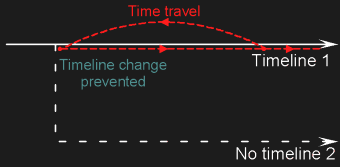
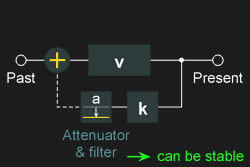
Prevention theory: timelines and equivalent system
Sketching up a system for this one theory was hard. We do not know how a system must look like if, at some point, it simply cuts or reduces the feedback so that it can't do any harm. It may not even be LTI as it is required for stability considerations. So I just ended up inserting some sort of filter or attenuator that prevents the loop from becoming unstable. Tiny changes of the output, the present, may be allowed as long as the system is stable. The requirement of stability here denotes that the change of the timeline is small enough to still allow the time travel to happen.
The time traveler is not allowed to kill his grandfather, but it is uncertain whether he would be able to influence Shakespeare. Maybe not as much as giving him a collection of his own works and allowing him to be lazy all of his life. And definitely not as much as giving him old manuscripts that would age and wear infinitely.
5. Predestination theory
In order to permit interaction with people and objects while being in the past and nonetheless avoid the grandfather paradox, some authors assume a predetermined timeline as a second option to comply with the Novikov self-consistency principle. In this case, the actions of the time traveler lead exactly to the future the time traveler knows, even if he tries to achieve the opposite. In other words, the timeline is unchangeable from the very beginning of time to eternity. As already mentioned, this is also referred to as a causality loop or a "predestination paradox", although it technically isn't a paradox if we accept predestination as a valid principle.
The concept of predetermination has worked with some Star Trek episodes such as TOS: "Assignment: Earth", where the Enterprise crew is responsible for a nuclear detonation in the atmosphere in the 1960's, which will be exactly the reason for their time travel 300 years later. The same goes for the TNG episode "Time's Arrow". Here Data's head is found in a cave, which is the incentive for a time travel in the course of which Data actually loses his head. In these stories there is only one timeline and they are therefore self-consistent. On the other hand, the two episodes are inconsistent with the many cases in Star Trek where an old timeline is substituted with a new one. Still, the concept of predestination must exist in the Star Trek Universe. Otherwise Dulmer and Lucsly wouldn't hate it (DS9: "Trials and Tribble-ations").
Although not quite as obviously as in the prevention theory, the concept of a predestined timeline is also an offense against free will. If we are confined to one timeline although time travel is possible, our lives are predetermined as is the whole universe. If we are not able to control our life in the past, we can't do it in the present or future either, since time does not "know" whether a person is a time traveler changing history or a "legitimate" person that belongs into this time. The same dilemma as with the closely related concept of self-fulfilling prophecies arises. Any action inevitably leads to the predicted future. All decisions that seem to originate from our brains are then actually controlled by an omnipotent force that is pulling the strings. Like with the prevention theory too, an approach to develop a logical time travel concept ultimately turns into a theological problem.
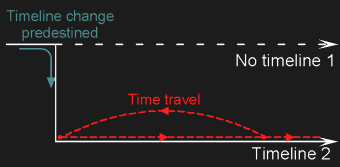
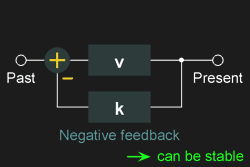
Predestination theory: timelines and equivalent system
Let us look at the system. At the first glance it is identical to the one of the oscillation theory. The decisive difference is the minus sign of the feedback at the summation point. Although I could have labeled the feedback block "-k" or "k<0" as well, I left out the minus sign of that block simply to show that not the feedback block (the action of the time traveler), but what is made of it is different here. The time traveler may think he's doing something that leads to positive feedback because he plans something highly disruptive such as killing his grandpa or detonating a nuclear weapon in ancient Rome, but in fact it's negative ("positive" and "negative" in a mathematical sense!). The attempt to change the past is either thwarted against all expectations (like it happens because of the never explained adverse conditions in Stephen King's 11/22/63). Or the action leads to the opposite of the intended result, that the known past is enabled instead of altered (the Pogo paradox).
Moreover, it is interesting to note that the output is never determined by the transfer function of the feedforward path alone (well, maybe in the very first moment when an omnipotent observer switches the system on). The stable output signal is always a function of both the forward and the feedback path. The fact that the output is stabilized just because of the feedback corresponds to the statement that everything in such a universe is predestined.
Although it seems to be overall consistent and the grandfather paradox is no issue, the predestination theory allows the ontological paradox. Something like Shakespeare's manuscripts, the information as well as the very paper, may come to existence from nothing! As elegantly as the grandfather paradox is barred (albeit with giving up the principle of free will), as utterly fails the attempt to do something about the ontological paradox. Predestination is the only one of the five theories where the natures of the two paradoxes are very different.
Side note There are a few uncertain candidates for the ontological paradox in Star Trek. The most obvious one is when Riker tells Cochrane "Don't try to be a great man..." in "Star Trek: First Contact", something that he knew the warp pioneer once said. So the quote may have come to existence from nothing. Ultimately even the name "Enterprise" may have been created like that, bearing in mind that there is suddenly a famous ship NX-01 that we didn't know so far. Another candidate may be the glasses that McCoy gave to Kirk, or even the formula for transparent aluminium that Plexicorp "could have invented" and maybe always had in the Trek Universe.
6. Immunity theory
It is still left to explain how the "regular" time travels in Star Trek can possibly work, the ones in which history is actually changed, without being predetermined. We can notice that in Star Trek, like in most other science fiction series and movies, the grandfather paradox never occurs, at least not immediately. Someone who travels to the past and alters history is never affected by the change, will continue to exist and will keep all memories from the future that is no more. A certain limited number of people staying behind in the present are often protected likewise, although in this case, whether explicitly mentioned or not, their "temporal shielding" is plot-driven because it is their task to fix the damage. In any case protection against changes of the timeline is a quite common phenomenon. And as already mentioned, there must be something final and unambiguous about the result of a time travel, as we couldn't possibly want the Star Trek Universe to oscillate between an ever growing number of states.
We have got the doubling theory to explain how history can be changed without paradoxes, but it doesn't really work for Star Trek. Because why should the crews of Kirk, Picard, Sisko, Janeway and Archer have been hell-bent on fixing any time travel accident if it "only" created a new universe that should be better left on its own? "Star Trek (2009)" is the only occasion in Trek's history where the characters have such a fatalistic view of timeline changes. Also, every time without exception that characters returned from the past where they had caused a timeline change, they wound up in the future of the new timeline, never in the old continuity. Likewise, those who were left behind in the present suddenly found themselves in an altered universe, just as the Defiant in DS9: "Past Tense". If the Federation still existed in the old timeline, why didn't the ship remain there, why did it make the apparent transition to another universe in the first place?
So if the timeline does not oscillate, and if there are no two simultaneous timelines either, how can time travel work without producing a paradox? It is certainly not the most elegant explanation, but what if time simply doesn't care about the discontinuity of someone coming from a timeline that doesn't exist any longer? This could explain most of what we can see in Trek's time travel episodes and movies. History may have been changed the very instant when Gabriel Bell was killed in DS9: "Past Tense", but Sisko, Dax and Bashir don't simply vanish. Why should they? They are obviously protected just like the Defiant that is now in orbit around a planet Earth without space travel in the 24th century. Likewise, Tasha Yar, who has come to life again in the intermediate timeline, doesn't vanish from the Enterprise-C when the ship is sent back through the rift in TNG: "Yesterday's Enterprise". And it is no surprise that she continues to exist because otherwise it would have been utterly pointless for her to join the ship's crew just to vanish anyway.
So the grandfather paradox is eluded through "immunity" of the time traveler. But what about the ontological paradox? Well, Shakespeare's works would be protected in the very same fashion as the time traveler who brings them to the past. The Shakespeare of the new timeline may or may not reproduce the works of the other Shakespeare as they are. Like in the theories 1-3, the ontological paradox is averted just like the grandfather paradox.
Other Problems of Time Travel
Apart from the grandfather paradox, time travel may be bear several other problems. Still, the following problems are mostly quantitative or technical ones and can be solved with the help of additional (yet sometimes complicated) explanations.
The conservation problem
In the case we assume more than one timeline, conservation of energy (and mass) can be regarded as a potentially more fundamental argument against time travel than the possibility of the grandfather paradox. But it may pose no problem if we expand energy conservation to include multiple universes. If there is no more general obstacle, the problem is reduced to the grandfather paradox or the ontological paradox.
The acceleration problem
A number of time travel concepts are based on a kind of "time portal" (e.g. TOS: "The City on the Edge of Forever", "All Our Yesterdays"). If there is an analogy to space travel, an energy-consuming acceleration is required in order to initiate the time travel and achieve a certain time speed. So the time portals that allow to arrive in the past in an instant must provide far more energy than, for example, a starship used for time travel.
The spatial motion problem
Time travel stories naturally focus on the temporal movement. Actually, in most stories the time traveler arrives at the same place where he started from, i.e. the same place with respect to the local coordinates usually on Earth where his time machine is located. This appears to be reasonable at first, but it is only possible if the time machine remains within the three dimensions of normal space for the whole journey and is therefore subjected to gravity and other forces. Otherwise the machine would remain at a position that would probably be in deep space at the time of arrival, owing to the movements of planet, sun and galaxy. It is hard to explain if the time machine arrives at the same place on Earth though it has actually left Earth for the duration of the travel. In this case the machine must possess a kind of propulsion system, which would make time travels far more complicated and less plausible. The same applies to time portals that show another environment on the other side that is located somewhere else, maybe even on a remote planet. In case of a time travel by starship, using the slingshot effect for instance, the spatial motion problem is inherently less severe, since the ship is moving through space anyway. Still, it is debatable that in almost every Star Trek time travel shown so far (e.g. TOS: "Tomorrow is Yesterday", "Star Trek IV: The Voyage Home", "Star Trek VIII: First Contact") the starship almost "naturally" arrives within the same star system where it started the time travel.
The radiation problem
If, however, the machine remains in the same place for the whole journey and is not immune to gravity and other effects, it is also visible or at least detectable for the whole time, unless we postulate the use of a cloaking device. The time traveler looking out of his machine sees a very fast changing world, according to his time speed. Using the VCR analogy it is quick motion reverse to him for traveling back and quick motion forward for traveling forward in time, respectively. Vice versa the outer world perceives a still or very slowly moving time traveler, according to the reciprocal of time speed. We did not yet take into account that the different time levels will lead to a wavelength shift of radiation that exits or enters the influence range of the time machine. The effect is similar as the general relativistic spectral shift which is attributed to different gravitation potentials. Outgoing radiation will be shifted to red, since every photon oscillation inside the machine refers to a shorter time than outside. So a human being in the external world cannot see the time travel, but has to use very sensitive infrared detectors or radio frequency antennas, for the received power also decreases. Vice versa, the situation is much more severe for the time traveler, who will be bombarded by intensive UV and X-rays to which the normal solar spectrum on Earth will be converted. In fact, the time machine is exposed to the accumulated energy dose of the entire external time that elapses during the journey! It is certainly not advisable for the inventor to build a window into his machine. Much rather it should possess a thick shielding. By the way, this is also necessary for a starship traveling at relativistic speed or even warp speed due to the intensive Doppler effect.
The detection/interaction problem
Though probably not visible to the human eye, interaction of the outer world and the time machine is nevertheless possible. We get an impression of what might be the effect of entering a temporal anomaly (which is a similar phenomenon as a time machine) in TNG: "Timescape", where entering a different time zone evokes physical and psychosomatic pains. Nevertheless it is pure speculation what will happen to someone who crosses the time barrier and tries to touch the time machine or even to open and enter it and what will happen to the time traveler in this case. Still, if the machine can be observed for centuries, it is quite probable that many people will try to solve its mystery and potentially endanger the time traveler*. Moreover, even if it is not possible to disturb the time travel, the mere existence of the time machine will have an effect on the people watching their infrared detector readings, and it may cause a paradox in case of a travel back in time.
* I wrote this long before the fantastic episode "Blink of an Eye", where exactly this happens. Voyager, "frozen" in a planet's sky for many centuries, is called the "skyship" by the local population.
The time travel inflation problem
If we assume that time travel is theoretically possible, then human ingenuity will lead to a physical solution and finally to the invention of time travel some day. If it is possible in the future, an inflationary number of travels to the past will be enabled during the lifetime of the time-traveling civilization to come. In thousands of years of human history lots of time machines should have already been sighted and possibly altered history. There are a number of possible explanations for the obvious lack of time travels:
1. We may assume that an advanced human civilization can rather handle the problems of time travel than our current governments could. Still, even if time travel is restricted by law (e.g. by the Temporal Prime Directive mentioned in VOY: "Future's End", DS9: "Trials and Tribble-ations", DS9: "Wrongs Darker than Death or Night" and VOY: "Timeless"), misuse cannot efficiently be prevented, let alone over a period of many millennia.
2. The Vulcans' reason not to visit Earth before the invention of warp propulsion in "Star Trek VIII: First Contact" (an excuse which will later become the convenient Prime Directive) could also apply to our successors: Our civilization could be too primitive to explore, there is nothing of interest for a vastly advanced human race.
3. Maybe the lack of time machines is a sign that human civilization will cease to exist soon. No future - no time machines.
4. Another explanation could be that history has already been altered for many times, leading to paradoxes we are not able to perceive. It is even possible that our timeline is frequently changing without anyone noticing it. We are just to "stupid" to see that we are constantly affected by time travels.
5. Maybe we are repeatedly visited by our advanced descendants, and some of our contemporaries have noticed it, since the frequently observed UFOs are actually their time machines :-).
Side note A similar question arises if we estimate the probability of alien visitors on our planet, taking into account the number of inhabitable ("M class") planets, the probability for the evolution of life and the expected lifetime of a civilization that should be sufficient to develop interstellar space travel. The result is that our galaxy should be full of civilizations which are able to visit us. Yet, alien visitors have never been confirmed (sorry, Roswell believers). This problem is called Fermi paradox, and is further explained in the Astronomy FAQ.
Conclusion
The danger of the grandfather paradox is the most severe of the above discussed time travel problems, since it cannot be solved just by additional explanations. Once this paradox occurs, it is virtually impossible for a science fiction author to continue with his story, unless he ignores or even fails to recognize the paradox, which unfortunately happens very often. The ontological paradox is not as common or not as obvious, but the necessity to elude it is much the same. The possibility of a paradox, however, is not a reason why time travel shouldn't be possible. If time travel is physically or even technically possible some day, there must also be a logical solution, and most likely it is our restricted perception that prevents us from recognizing this solution. Summarizing the outlined theories of time travel, there are four basic possibilities for the paradox:
- A paradox does occur but is resolved, or more precisely, it would occur from our viewpoint if we were able to perceive it. We cannot perceive it, since we are caught in our timeline, i.e. in the timeline that is currently valid for us. This is in short what is outlined in the oscillation and doubling theories.
- A paradox does not occur, since the change in the timeline neither affects the time traveler himself nor the time traveler's future to which he would return. The course of time theory can only be maintained by complicated additional explanations. Still, it allows time travel without remorse.
- A paradox, or at least the grandfather paradox, does not occur in a self-consistent timeline,because an omnipotent force prevents us from causing one. This is the short summary of the prevention and predestination theories.
- A paradox does not occur because while the time traveler may change his own future, he himself is excluded from the effect. This theory is certainly not very elegant, but it explains what we usually see on Star Trek, as well as in most other science fiction. I call this the immunity theory.
None of the above theories is completely satisfactory, since their physical background is weak. They might at least serve as guidelines for science fiction authors to write consistent stories. Maybe a universal theory will be found in the future, maybe the solution is already buried in existing theories, e.g. special relativity. The conclusion is that there is no need to be pessimistic about the feasibility of time travel. Thank you for your patience with this time travel page that was difficult to compile and probably also difficult to understand.
See you yesterday!
Credits
Some screen caps from TrekCore. Thanks to Mark Mendel and Daniel Wells for suggestions about the ontological paradox, to Stéphane for a correction about "Terminator II" and to Daniel Pharos who suggested to mention that the region outside the light cone is "safe".






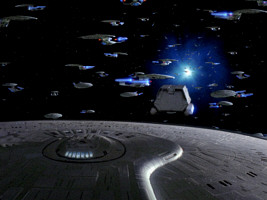
 Many Enterprises in TNG: "Parallels"
Many Enterprises in TNG: "Parallels"